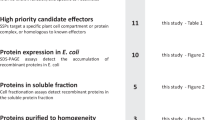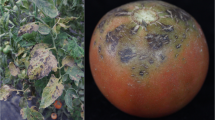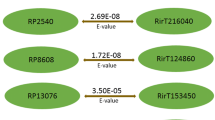Abstract
The effector proteins produced by plant pathogens are one of the essential components of host–pathogen interaction. Despite being important, most of the effector proteins remain unexplored due to the diversity in their primary sequence generated by the high selection pressure of the host immune system. However to maintain the primary function in the infection process, these effectors may tend to maintain their native protein fold to perform the corresponding biological function. In the present study, unannotated candidate secretory effector proteins of sixteen major plant fungal pathogens were analyzed to find the conserved known protein folds using homology, ab initio, and Alpha Fold/Rosetta Fold protein dimensional (3D) structure approaches. Several unannotated candidate effector proteins were found to match various known conserved protein families potentially involved in host defense manipulation in different plant pathogens. Surprisingly a large number of plant Kiwellin proteins fold like secretory proteins (> 100) were found in studied rust fungal pathogens. Many of them were predicted as potential effector proteins. Furthermore, template independent modelling using Alpha Fold/Rosetta Fold analysis and structural comparison of these candidates also predicted them to match with plant Kiwellin proteins. We also found plant Kiwellin matching proteins outside rusts including several non-pathogenic fungi suggesting the broad function of these proteins. One of the highest confidently modeled Kiwellin matching candidates effectors, Pstr_13960 (97.8%), from the Indian P. striiformis race Yr9 was characterized using overexpression, localization, and deletion studies in Nicotiana benthamiana. The Pstr_13960 suppressed the BAX-induced cell death and localized in the chloroplast. Furthermore, the expression of the Kiwellin matching region (Pst_13960_kiwi) alone suppressed the BAX-induced cell death in N. benthamiana despite the change of location to the cytoplasm and nucleus, suggesting the novel function of the Kiwellin core fold in rust fungi. Molecular docking showed that Pstr_13960 can interact with plant Chorismate mutases (CMs) using three loops conserved in plant and rust Kiwellins. Further analysis of Pstr_13960 showed to contain Intrinsically disordered regions (IDRs) in place of the N-terminal β1/β2 region found in plant Kiwellins suggesting the evolution of rust Kiwellins-like effectors (KLEs). Overall, this study reports the presence of a Kiwellin protein–like fold containing a novel effector protein family in rust fungi depicting a classical example of the evolution of effectors at the structure level as Kiwellin effectors show very low significant similarity to plant Kiwellin at the sequence level.












Similar content being viewed by others
Data availability
All data generated or analyzed during this study are included in this article.
References
Jaswal, R., Kiran, K., Rajarammohan, S., Dubey, H., Singh, P. K., Sharma, Y., Deshmukh, R., Sonah, H., Gupta, N., & Sharma, T. R. (2020). Effector biology of biotrophic plant fungal pathogens: Current advances and future prospective. Microbiological Research. https://doi.org/10.1016/j.micres.2020.126567
Xu, Q., Tang, C., Wang, L., Zhao, C., Kang, Z., & Wang, X. (2020). Haustoria – arsenals during the interaction between wheat and Puccinia striiformis f.sp. tritici. Molecular Plant Pathology. https://doi.org/10.1111/mpp.12882
Yousefi, S. R., Alshamsi, H. A., Amiri, O., & Salavati-Niasari, M. (2021). Synthesis, characterization and application of Co/Co3O4 nanocomposites as an effective photocatalyst for discoloration of organic dye contaminants in wastewater and antibacterial properties. Journal of Molecular Liquids, 337, 116405.
Vleeshouwers, V. G. A. A., & Oliver, R. P. (2014). Effectors as tools in disease resistance breeding against biotrophic, hemibiotrophic, and necrotrophic plant pathogens. Molecular plant-microbe interactions, 27(3), 196–206.
Jaswal, R., Rajarammohan, S., Dubey, H., & Sharma, T. R. (2020). Smut fungi as a stratagem to characterize rust effectors: Opportunities and challenges. World Journal of Microbiology and Biotechnology, 36(10), 1–10.
Kangara, N., Kurowski, T. J., Radhakrishnan, G. V., Ghosh, S., Cook, N. M., Yu, G., Arora, S., Steffenson, B. J., Figueroa, M., Mohareb, F., & Saunders, D. G. (2020). Mutagenesis of puccinia graminis f.sp. tritici and selection of gain-of-virulence mutants. Frontiers in plant science, 11, 570180.
Miller, M. E., Nazareno, E. S., Rottschaefer, S. M., Riddle, J., Dos Santos Pereira, D., Li, F., Nguyen-Phuc, H., Henningsen, E. C., Persoons, A., Saunders, D. G., & Stukenbrock, E. (2020). Increased virulence of Puccinia coronata f. sp.avenae populations through allele frequency changes at multiple putative Avr loci. PLoS Genetics, 16(12), e1009291.
Mukhi, N., Gorenkin, D., & Banfield, M. J. (2020). Exploring folds, evolution and host interactions: understanding effector structure/function in disease and immunity. New Phytologist. https://doi.org/10.1111/nph.16563
De Guillen, K., Lorrain, C., Tsan, P., Barthe, P., Petre, B., Saveleva, N., Rouhier, N., Duplessis, S., Padilla, A., & Hecker, A. (2019). Structural genomics applied to the rust fungus Melampsora larici-populina reveals two candidate effector proteins adopting cystine knot and NTF2-like protein folds. Scientific Reports, 9(1), 1–12.
Guo, L., Cesari, S., de Guillen, K., Chalvon, V., Mammri, L., Ma, M., Meusnier, I., Bonnot, F., Padilla, A., Peng, Y. L., & Liu, J. (2018). Specific recognition of two MAX effectors by integrated HMA domains in plant immune receptors involves distinct binding surfaces. Proceedings of the National Academy of Sciences, 115(45), 11637–11642.
de Guillen, K., Ortiz-Vallejo, D., Gracy, J., Fournier, E., Kroj, T., & Padilla, A. (2015). Structure analysis uncovers a highly diverse but structurally conserved effector family in phytopathogenic fungi. PLoS pathogens. https://doi.org/10.1371/journal.ppat.1005228
Pennington, H. G., Jones, R., Kwon, S., Bonciani, G., Thieron, H., Chandler, T., Luong, P., Morgan, S. N., Przydacz, M., Bozkurt, T., & Bowden, S. (2019). The fungal ribonuclease-like effector protein CSEP0064/BEC1054 represses plant immunity and interferes with degradation of host ribosomal RNA. PLoS Pathogens, 15(3), e1007620.
Outram, M. A., Figueroa, M., Sperschneider, J., Williams, S. J., & Dodds, P. N. (2022). Seeing is believing: Exploiting advances in structural biology to understand and engineer plant immunity. Current Opinion in Plant Biology, 67, 102210.
Seong, K., & Krasileva, K. (2021). Computational structural genomics unravels common folds and novel families in the secretome of fungal phytopathogen Magnaporthe oryzae. Molecular Plant-Microbe Interactions. https://doi.org/10.1094/MPMI-03-21-0071-R
Jumper, J., Evans, R., Pritzel, A., Green, T., Figurnov, M., Ronneberger, O., Tunyasuvunakool, K., Bates, R., Žídek, A., Potapenko, A., & Bridgland, A. (2021). Highly accurate protein structure prediction with AlphaFold. Nature, 596(7873), 583–589.
Mirdita, M., Schütze, K., Moriwaki, Y., Heo, L., Ovchinnikov, S., & Steinegger, M. (2022). ColabFold: Making protein folding accessible to all. Nature Methods. https://doi.org/10.1038/s41592-022-01488-1
Yu, D. S., Outram, M. A., Smith, A., McCombe, C. L., Khambalkar, P. B., Rima, S. A., Sun, X., Ma, L., Ericsson, D. J., Jones, D. A., & Williams, S. J. (2021). The structural repertoire of Fusarium oxysporum f. sp. lycopersici effectors revealed by experimental and computational studies. bioRxiv. https://doi.org/10.1101/2021.12.14.472499
Rocafort, M., Bowen, J. K., Hassing, B., Cox, M. P., McGreal, B., de la Rosa, S., Plummer, K. M., Bradshaw, R. E., & Mesarich, C. H. (2022). The Venturia inaequalis effector repertoire is expressed in waves, and is dominated by expanded families with predicted structural similarity to avirulence proteins from other fungi. bioRxiv. https://doi.org/10.1101/2022.03.22.482717
Seong, K., & Krasileva, K. (2022). Comparative computational structural genomics highlights divergent evolution of fungal effectors. bioRxiv. https://doi.org/10.1101/2022.05.02.490317
Hamiaux, C., Maddumage, R., Middleditch, M. J., Prakash, R., Brummell, D. A., Baker, E. N., & Atkinson, R. G. (2014). Crystal structure of kiwellin, a major cell-wall protein from kiwifruit. Journal of structural biology, 187(3), 276–281.
Han, X., Altegoer, F., Steinchen, W., Binnebesel, L., Schuhmacher, J., Glatter, T., Giammarinaro, P. I., Djamei, A., Rensing, S. A., Reissmann, S., & Kahmann, R. (2019). A kiwellin disarms the metabolic activity of a secreted fungal virulence factor. Nature, 565(7741), 650–653.
Wildermuth, M. C. (2019). Plants fight fungi using kiwellin proteins. Nature. https://doi.org/10.1038/d41586-019-00092-2
Bange, G., & Altegoer, F. (2019). Plants strike back: Kiwellin proteins as a modular toolbox for plant defense mechanisms. Communicative & integrative biology, 12(1), 31–33.
Altegoer, F., Weiland, P., Giammarinaro, P. I., Freibert, S. A., Binnebesel, L., Han, X., Lepak, A., Kahmann, R., Lechner, M., & Bange, G. (2020). The two paralogous kiwellin proteins KWL1 and KWL1-b from maize are structurally related and have overlapping functions in plant defense. Journal of Biological Chemistry, 295(23), 7816–7825.
Kiran, K., Rawal, H. C., Dubey, H., Jaswal, R., Devanna, B. N., Gupta, D. K., Bhardwaj, S. C., Prasad, P., Pal, D., Chhuneja, P., & Balasubramanian, P. (2016). Draft genome of the wheat rust pathogen (Puccinia triticina) unravels genome-wide structural variations during evolution. Genome Biology and Evolution, 8(9), 2702–2721.
Kiran, K., Rawal, H. C., Dubey, H., Jaswal, R., Bhardwaj, S. C., Prasad, P., Pal, D., Devanna, B. N., & Sharma, T. R. (2017). Dissection of genomic features and variations of three pathotypes of Puccinia striiformis through whole genome sequencing. Scientific Reports. https://doi.org/10.1038/srep42419
Cortázar, A. R., Aransay, A. M., Alfaro, M., Oguiza, J. A., & Lavín, J. L. (2014). Secretool: Integrated secretome analysis tool for fungi. Amino Acids, 46(2), 471–473.
Lu, S., Wang, J., Chitsaz, F., Derbyshire, M. K., Geer, R. C., Gonzales, N. R., Gwadz, M., Hurwitz, D. I., Marchler, G. H., Song, J. S., & Thanki, N. (2020). CDD/SPARCLE: The conserved domain database in 2020. Nucleic acids research, 48(D1), D265–D268.
Finn, R. D., Bateman, A., Clements, J., Coggill, P., Eberhardt, R. Y., Eddy, S. R., Heger, A., Hetherington, K., Holm, L., Mistry, J., & Sonnhammer, E. L. (2013). Pfam: The protein families database. Nucleic Acids Research, 42(D1), D222–D230.
Sperschneider, J., Dodds, P. N., Gardiner, D. M., Singh, K. B., & Taylor, J. M. (2018). Improved prediction of fungal effector proteins from secretomes with EffectorP 2.0. Molecular Plant Pathology, 19(9), 2094–2110.
Kelley, L. A., Mezulis, S., Yates, C. M., Wass, M. N., & Sternberg, M. J. E. (2015). The Phyre2 web portal for protein modeling, prediction and analysis. Nature protocols, 10(6), 845–858.
Yang, J., Yan, R., Roy, A., Xu, D., Poisson, J., & Zhang, Y. (2015). The I-TASSER Suite: Protein structure and function prediction. Nature methods, 12(1), 7–8.
Kim, D. E., Chivian, D., & Baker, D. (2004). Protein structure prediction and analysis using the Robetta server. Nucleic Acids Research. https://doi.org/10.1093/nar/gkh468
Baek, M., DiMaio, F., Anishchenko, I., Dauparas, J., Ovchinnikov, S., Lee, G. R., Wang, J., Cong, Q., Kinch, L. N., Schaeffer, R. D., Millán, C., Park, H., Adams, C., Glassman, C. R., DeGiovanni, A., Pereira, J. H., Rodrigues, A. V., van Dijk, A. A., Ebrecht, A. C., Opperman, D. J., Sagmeister, T., Buhlheller, C., Pavkov-Keller, T., Rathinaswamy, M. K., Dalwadi, U., Yip, C. K., Burke, J. E., Garcia, K. C., Grishin, N. V., Adams, P. D., Read, R. J,, & Baker, D. (2021) Accurate prediction of protein structures and interactions using a three-track neural network. Deep learning takes on protein folding. Science, 373(6557), 871–876. https://doi.org/10.1126/science.abj8754
Ramírez-Aportela, E., López-Blanco, J. R., & Chacón, P. (2016). FRODOCK 2.0.: Fast protein–protein docking server. Bioinformatics, 32(15), 2386–2388.
Katoh, K., Rozewicki, J., & Yamada, K. D. (2019). MAFFT online service: Multiple sequence alignment, interactive sequence choice and visualization. Briefings in Bioinformatics, 20(4), 1160–1166.
Bailey, T. L., Boden, M., Buske, F. A., Frith, M., Grant, C. E., Clementi, L., Ren, J., Li, W. W., & Noble, W. S. (2009). MEME SUITE: Tools for motif discovery and searching. Nucleic Acids Research. https://doi.org/10.1093/nar/gkp335
Peng, Z., Mizianty, M. J., & Kurgan, L. (2014). Genome-scale prediction of proteins with long intrinsically disordered regions. Proteins: Structure Function, and Bioinformatics, 82(1), 145–158.
Mészáros, B., Erdős, G., & Dosztányi, Z. (2018). IUPred2A: Context-dependent prediction of protein disorder as a function of redox state and protein binding. Nucleic acids research, 46(W1), W329–W337.
Xue, B., Dunbrack, R. L., Williams, R. W., Dunker, A. K., & Uversky, V. N. (1804). (2010) PONDR-FIT: A meta-predictor of intrinsically disordered amino acids. Biochimica et Biophysica Acta (BBA)-Proteins and Proteomics, 1804(4), 996–1010.
Emanuelsson, O., Nielsen, H., & Heijne, G. V. (1999). ChloroP, a neural network-based method for predicting chloroplast transit peptides and their cleavage sites. Protein Science, 8(5), 978–984.
Horton, P., Park, K.-J., Obayashi, T., Fujita, N., Harada, H., Adams-Collier, C. J., & Nakai, K. (2007). WoLF PSORT: Protein localization predictor. Nucleic Acids Research. https://doi.org/10.1093/nar/gkm259
Sperschneider, J., Catanzariti, A. M., DeBoer, K., Petre, B., Gardiner, D. M., Singh, K. B., Dodds, P. N., & Taylor, J. M. (2017). LOCALIZER: Subcellular localization prediction of both plant and effector proteins in the plant cell. Scientific Reports. https://doi.org/10.1038/srep44598
Barsoum, M., Sabelleck, B., Spanu, D. P., & Panstruga, R. (2019). Rumble in the effector jungle: Candidate effector proteins in interactions of plants with powdery mildew and rust fungi. Critical Reviews in Plant Sciences, 38(4), 255–279.
Vandhana, T. M., Reyre, J., Sushmaa, D., Berrin, J., Bissaro, B., & Madhuprakash, J. (2022). On the expansion of biological functions of lytic polysaccharide monooxygenases. New Phytologist, 233(6), 2380–2396.
Jagadeeswaran, G., Veale, L., & Mort, A. J. (2021). Do lytic polysaccharide monooxygenases aid in plant pathogenesis and herbivory? Trends in plant science, 26(2), 142–155.
Sabbadin, F., Urresti, S., Henrissat, B., Avrova, A. O., Welsh, L. R., Lindley, P. J., Csukai, M., Squires, J. N., Walton, P. H., Davies, G. J., & Bruce, N. C. (2021). Secreted pectin monooxygenases drive plant infection by pathogenic oomycetes. Science, 373(6556), 774–779.
Miller, M. E., Zhang, Y., Omidvar, V., Sperschneider, J., Schwessinger, B., Raley, C., Palmer, J. M., Garnica, D., Upadhyaya, N., Rathjen, J., & Taylor, J. M. (2018). De novo assembly and phasing of dikaryotic genomes from two isolates of Puccinia coronate f. sp. avenae, the causal agent of oat crown rust. MBio, 9(1), e01650-17.
Schwessinger, B., Sperschneider, J., Cuddy, W. S., Garnica, D. P., Miller, M. E., Taylor, J. M., Dodds, P. N., Figueroa, M., Park, R. F., & Rathjen, J. P. (2018). A near-complete haplotype-phased genome of the dikaryotic wheat stripe rust fungus Puccinia striiformis f. sp. tritici reveals high interhaplotype diversity. MBio, 9(1), e02275-17.
Offermann, L. R., Giangrieco, I., Perdue, M. L., Zuzzi, S., Santoro, M., Tamburrini, M., Cosgrove, D. J., Mari, A., Ciardiello, M. A., & Chruszcz, M. (2015). Elusive structural, functional, and immunological features of Act d 5, the green kiwifruit kiwellin. Journal of Agricultural and Food Chemistry, 63(29), 6567–6576.
Wood, K. J., Nur, M., Gil, J., Fletcher, K., Lakeman, K., Gann, D., Gothberg, A., Khuu, T., Kopetzky, J., Naqvi, S., & Pandya, A. (2020). Effector prediction and characterization in the oomycete pathogen Bremia lactucae reveal host-recognized WY domain proteins that lack the canonical RXLR motif. PLoS pathogens, 16(10), e1009012.
Lu, S., Shen, X., & Chen, B. (2017). Development of an efficient vector system for gene knock-out and near in-cis gene complementation in the sugarcane smut fungus. Scientific reports, 7(1), 1–8.
Shen, D., Li, Q., Sun, P., Zhang, M., & Dou, D. (2017). Intrinsic disorder is a common structural characteristic of RxLR effectors in oomycete pathogens. Fungal Biology, 121(11), 911–919. https://doi.org/10.1016/j.funbio.2017.07.005
Yang, L. N., Liu, H., Duan, G. H., Huang, Y. M., Liu, S., Fang, Z. G., Wu, E. J., Shang, L., & Zhan, J. (2020). The Phytophthora infestans AVR2 effector escapes R2 recognition through effector disordering. Molecular Plant-Microbe Interactions, 33(7), 921–931.
Acknowledgements
TRS is thankful to the Department of Science and Technology, Govt. of India, for JC Bose National Fellowship. RJ is thankful to the University Grants Commission (UGC), New Delhi for providing Junior Research Fellowship (JRF). The authors also gratefully acknowledge Miss Aakriti Mehra for her assistance in confocal imaging experiments.
Author information
Authors and Affiliations
Contributions
Conceptualization: TRS and RJ. Data curation and experiments: RJ. Data analysis and writing first draft: RJ, SR, HD, KK, HR, HS, RD. Funding acquisition: TRS. Investigation: RJ. Methodology and writing final draft: TRS and RJ.
Corresponding author
Ethics declarations
Conflict of interests
The authors declare no conflict of interests.
Additional information
Publisher's Note
Springer Nature remains neutral with regard to jurisdictional claims in published maps and institutional affiliations.
Supplementary Information
Below is the link to the electronic supplementary material.
Rights and permissions
Springer Nature or its licensor (e.g. a society or other partner) holds exclusive rights to this article under a publishing agreement with the author(s) or other rightsholder(s); author self-archiving of the accepted manuscript version of this article is solely governed by the terms of such publishing agreement and applicable law.
About this article
Cite this article
Jaswal, R., Rajarammohan, S., Dubey, H. et al. Intrinsically Disordered Kiwellin Protein-Like Effectors Target Plant Chloroplasts and are Extensively Present in Rust Fungi. Mol Biotechnol 66, 845–864 (2024). https://doi.org/10.1007/s12033-023-00717-y
Received:
Accepted:
Published:
Issue Date:
DOI: https://doi.org/10.1007/s12033-023-00717-y




